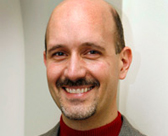Living Counter Culturally, Living Together
What a French Film Taught Me about Living as a Christian

The Intouchables
Based on a true story, the film follows Driss, a young immigrant man from Senegal (played by Omar Sy) who is hired to care for Philippe, a very wealthy quadriplegic about 25 years his senior (Françios Cluzet). Injured in a paragliding accident, Philippe is not looking for another deferential caretaker with impeccable training and a smooth, if pitying, manner. He is looking for a way out of his isolated and immobile world. Driss provides this. Serving as Philippe’s arms and legs, Driss brings himself – his rough masculinity, his unaffected manner – into Philippe’s world, forever changing his relationship with his own body and all those around him.
When I saw the film this summer, I thought back to this past May, when I gathered with a dozen or so other Wheaton faculty to consider this question of being in the world. Our animating question was, “How can Christians be a counter-culture rather than anti-cultural?” We considered this question first in relation to so-called academic culture, but then in relation to what we often call Popular Culture, particularly film. As I watched this film, it became a way to think about what it means to be counter-cultural. Just as a person cannot be “cultural” all by herself, so too do we require a relationship to be counter-cultural. We are always and forever in culture – being “anti-cultural” just means being a curmudgeon (or a hermit); it does not mean being outside culture. But this culture is not something created once and then carried around. It is constantly being re-created, re-imagined, and re-formed. Being counter-cultural means emphasizing the difference, inhabiting the world in another way, which for Christians is a Christian way. What the relationship of Driss and Philippe reminded me was that for any of us to overcome the isolation, conformity, and pressure of the culture, we must recognize our own limitations and our need for others, acting together to stretch beyond current limits.
At the beginning of the film it is easy to see Philippe’s limitations. The man is profoundly paralyzed, moving his chair via a small knob he can push with his chin. We first see him sitting behind his young female assistant as she interviews candidates for the job of his caretaker. Driss, who has been pacing in the gorgeous Louis XIV salon with the other candidates, becomes impatient and bursts into the room. “Sign the paper,” he demands. “Sign the paper saying you will not give me the job, so I can take it to the benefits office. This is the third one I need. Just sign the paper.” As the flustered assistant tries to make sense of this unorthodox intruder, Philippe moves for the first time. He drives his chair from behind the desk and says, “Come back tomorrow. We’ll have your paper for you.”
Driss returns to his home in the housing projects outside Paris, and we are introduced to his limits. We see his small apartment in which he is shoehorned with multiple younger children (we presume his siblings), including a younger teen boy who is clearly going down the wrong path in his young life. His mother returns, angry with Driss for being absent without contact, and she banishes him from the house, telling him that she can no longer worry about him. He is a man who must care for himself. And now he is alone.
When Driss returns to Philippe’s home the next day, he slowly becomes aware that the staff is not planning to merely give him the signed paper necessary for his government benefit, but that he has been hired, complete with his own room (and spacious bathroom) in the luxurious house. It’s clear he decides to accept the position primarily because he needs a place to stay.
The rest of the film is an unfolding of this relationship of these two men, one immobilized by his body, the other immobilized by his poverty and society. For the wealthy Philippe, society comes to him and he has tremendous access, yet he is mostly alone; his lawyers, assistants, and even relatives, all swirl around in a dance of the supplicants, waiting, as he says, for him to die. For Driss, his immobility is more hidden, but as a poor young black immigrant man, he is a perpetual outsider, a threat, a polluting presence. As he accompanies Philippe to the opera, or an art exhibition, Driss is an annoyance (at best), and a threat, at worst, to Philippe’s cultured companions, the proverbial bull in the French china shop. Philippe finds it all a genuine delight.
In Driss, Philippe not finds a physical mobility through Driss’s functioning arms and legs, but also a psychological – a spiritual – freedom through this relationship. Driss challenges the conventions of his social world, and in doing so, breaks down the barriers that have arisen between Philippe and all those around him, as well as between Driss and a world that has been out of reach. In this way, Driss also experiences mobility – a freedom – that comes from this relationship and the ways it changes his view of himself, his family, and his possibilities in French society. Together, they live a life that challenges their limits and changes the ways they inhabit the world; they live in a way that is, though clearly French, counter-culturally, and productively, so.
In considering this question of what it means for Christians to live counter-culturally, I often turn to a short chapter by theologian Miroslav Volf, entitled “When Gospel and Culture Intersect: Notes on the Nature of Christian Difference.” After a brief survey of ways the contemporary church positions itself vis a vis “the culture,” he argues for what he calls “internal difference.” The metaphor he uses is of a conquered people who subvert the laws, customs, and language of the colonizer. Quoting philosopher Michel de Certeu, Volf writes that colonized people “metaphorized the dominant order; they made it function in another register. They remained other within the system which they assimilated and which assimilated them externally. They diverted without leaving. Procedures of consumption maintained their difference in the very space that the occupier was organizing.” Driss and Philippe, and contemporary U.S. Christians, are not exactly colonized people, but we do find ourselves limited by conditions not of our choosing. We find ourselves within a system, and even a physical body, that is not as it should be. By connecting with others, becoming one another’s arms and legs, stretching each other’s social worlds, we create opportunities to inhabit these systems, and these bodies, differently, and, at least potentially, change the system from within.
I will end by referencing one of the articles read for our seminar by Catholic social theorist Margaret Archer. Although her concern is with civil society and Catholic social teaching, she argues that the enlightenment view of the individual, “defective models of personal identity,” which support secular views of the human, fail to provide a base for a Christian social ethic that affirms the dignity of the human person, solidarity, and concern for the common good. In other words, we cannot love our neighbor as ourselves, if we imagine ourselves to be, fundamentally, isolated individual with moral agency solely in ourselves. Instead, like Driss becoming Philippe’s limbs, and like Philippe providing the opportunity for Driss to move into new social and relational spheres, we are to understand that we are bound up with one another, profoundly part of one another as we live our lives. Our newfound movements, taken up on behalf and in concert with others, will not necessarily take us into wholly unfamiliar or worlds unknown (although they might!), but they will bring us together in relationships that transform the places, indeed the very bodies, we already have. We might not look different – we might not seem, at first, so counter-cultural – but we are, and, in Christ, we couldn’t be anything else.
Contact Us
Center for Applied Christian Ethics
117 Blanchard Hall
501 College Ave
Wheaton, IL 60187
